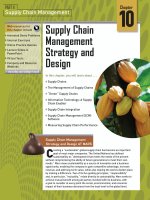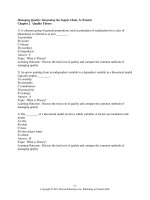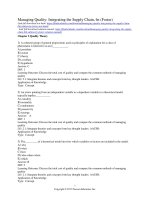Lecture Operations management: Creating value along the supply chain (Canadian edition) - Chapter 15
Bạn đang xem bản rút gọn của tài liệu. Xem và tải ngay bản đầy đủ của tài liệu tại đây (2.49 MB, 65 trang )
OPERATIONS MANAGEMENT:
Creating Value Along the Supply Chain,
Canadian Edition
Robert S. Russell, Bernard W. Taylor III, Ignacio Castillo, Navneet Vidyarthi
§
CHAPTER 15
Resource Planning
1
§
Learning Objectives
Material Requirements Planning (MRP)
Capacity Requirements Planning (CRP)
Enterprise Resource Planning (ERP)
Customer Relationship Management (CRM)
Supply Chain Management (SCM)
Product Lifecycle Management (PLM)
15-2
§
Resource Planning for
Manufacturing
15-3
§
Material Requirements Planning (MRP)
Computerized inventory control and production
planning system
When to use MRP?
Dependent demand items
Discrete demand items
Complex products
Job shop production
Assemble-to-order environments
15-4
§
Demand Characteristics
15-5
§
Material Requirements Planning
Master
production
schedule
Product
structure
file
Material
requirements
planning
Item
master
file
Planned
order
releases
Work
orders
Purchase
orders
Rescheduling
notices
15-6
§
MRP Inputs and Outputs
Inputs
Master production
schedule
Product structure file
Item master file
Outputs
Planned order releases
•
Work orders
•
Purchase orders
•
Rescheduling notices
15-7
§
Master Production Schedule
Drives MRP process with a schedule of finished
products
Quantities represent production not demand
Quantities may consist of a combination of
customer orders and demand forecasts
Quantities represent what needs to be produced,
not what can be produced
Quantities represent end items that may or may
not be finished products
15-8
§
Master Production Schedule
15-9
§
Product Structure File
15-10
§
Product Structure
Clipboard
Top clip (1)
Bottom clip (1)
Pivot (1)
Spring (1)
Rivets (2)
Finished clipboard
Pressboard (1)
15-11
§
Product Structure Tree
Level 0
Clipboard
Pressboard
(1)
Top Clip
(1)
Clip Ass’y
(1)
Bottom Clip
(1)
Rivets
(2)
Pivot
(1)
Level 1
Spring
(1)
15-12
§
Level 2
Multilevel Indented BOM
15-13
§
Specialized BOMs
Phantom bills
Transient subassemblies
Never stocked
Immediately consumed in next stage
K-bills
Group small, loose parts under pseudo-item number
Reduces paperwork, processing time, and file space
15-14
§
Specialized BOMs
Modular bills
Product assembled from major subassemblies and
customer options
Modular bill kept for each major subassembly
Simplifies forecasting and planning
X10 automobile example
•
•
3 x 8 x 3 x 8 x 4 = 2,304 configurations
3 + 8 + 3 + 8 + 4 = 26 modular bills
15-15
§
Modular BOMs
15-16
§
Time-phased Bills
An assembly chart shown against a time scale
15-17
§
Time-phased Bills
Forward scheduling
•
start at today‘s date and schedule forward to determine the earliest
date the job can be finished. If each item takes one period to
complete, the clipboards can be finished in three periods
Backward scheduling
•
start at the due date and schedule backwards to determine when to
begin work. If an order for clipboards is due by period three, we
should start production now
15-18
§
Item Master File
15-19
§
Item Master File
15-20
§
MRP Processes
Exploding the bill of material
Netting out the inventory
Netting
the process of subtracting on-hand quantities and
scheduled receipts from gross requirements to produce
net requirements
Lot sizing
•
determining the quantities in which items are usually made or
purchased
Time-phasing requirements
15-21
§
MRP Matrix
15-22
§
MRP
15-23
§
MRP
15-24
§
MRP - 1
15-25
§









